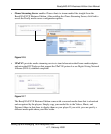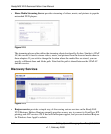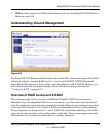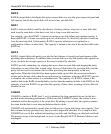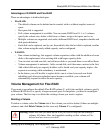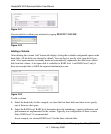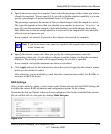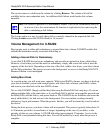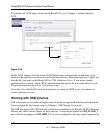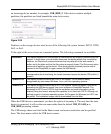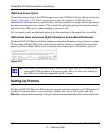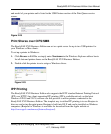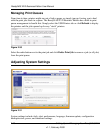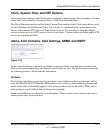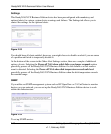
ReadyNAS NVX Business Edition User Manual
Setting Up and Managing Your ReadyNAS NVX 2-21
v1.1, February 2009
After you receive your e-mail, the ReadyNAS NVX Business Edition will have been expanded
with the capacity from your new disk(s).
Replacing All Your Disks for More Capacity
When you need more disk space and 2 TB disks are available at an attractive price, you can expand
your volume capacity by replacing the existing disks. Keep in mind that you must power down
several times to replace out your old disks.
First, power down the ReadyNAS, replace the first disk with the large-capacity disk, and then
reboot. If your ReadyNAS supports hot-swapping, you can hot-swap the disk without powering
down. The ReadyNAS will detect that a new disk was put in place and resynchronizes the disk
with data from the removed disk. This process takes an hour or longer, depending on disk capacity,
and you can use the ReadyNAS while the new disk synchronizes. Upon completion, replace the
second disk with another large-capacity disk, allow that disk to sync, and reboot. You can expand
to additional disks by doing the same thing as the 2nd disk: replace with a larger disk, allow the
disk to sync, and reboot.
Changing between X-RAID2 and Flex-RAID Modes
You can switch between X-RAID2 and Flex-X-RAID modes. The process involves setting the
ReadyNAS NVX Business Edition to the factory default and using RAIDar to configure the
volume during a 10-minute delay window during boot. See “Configuring RAID” on page 6-8 for
more information.
Working with iSCSI Target Volumes
The iSCSI target service enables you to create one or more iSCSI target volumes on the
ReadyNAS.
The iSCSI (Internet SCSI) protocol allows clients called initiators to send SCSI commands to
SCSI storage devices called targets on remote servers. It is a popular Storage Area Network (SAN)
protocol, allowing organizations to consolidate storage into data center storage arrays while
providing hosts such as databases and web servers with the illusion of locally-attached disks.
Unlike Fibre Channel, which requires special-purpose cabling, iSCSI can be run over long
distances using existing network infrastructure.
An iSCSI initiator sends SCSI commands over an IP network to an iSCSI target. Software to
provide an iSCSI initiator is available for most mainstream operating systems. Unlike network file
services where you access files in network share folders, the iSCSI target presents itself as a virtual
block device and can be treated like a locally attached disk to the client system acting as the iSCSI
initiator. Windows for instance could run FAT32 or NTFS on the iSCSI target device, and treat the
device as though it was locally attached.



